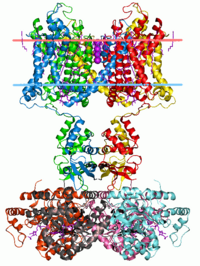
Photo from wikipedia
Carbamazepine has been shown to exert analgesic effects in clinical and experimental pain situation. This study was conducted to evaluate its potential peripheral antinociceptive effects and the possible involvement of… Click to show full abstract
Carbamazepine has been shown to exert analgesic effects in clinical and experimental pain situation. This study was conducted to evaluate its potential peripheral antinociceptive effects and the possible involvement of L-arginine/NO/cGMP/KATP channel pathway and PPARγ receptors in an animal model of pain. The antinociceptive effect induced by intraplantar administration of carbamazepine (100-1 000 μg/paw) was assessed using the formalin test in rats. To evaluate the involvement of L-arginine/NO/cGMP/KATP channel pathway in the antinociceptive action of carbamazepine, rats were pre-treated intraplantarlly with L-arginine (a nitric oxide precursor, 100 and 200 μg/paw), L-NAME (NOS inhibitor, 50 and 100 μg/paw), methylene blue (guanylyl cyclase inhibitor, 100 and 200 μg/paw), glibenclamide (KATP channel blocker, 100 and 200 μg/paw), and diazoxide (400 μg/paw). Moreover, to investigate the possible involvement of PPARγ receptors, pioglitazone (10 μg/paw; a PPARγ agonist) alone or in combination with GW9662 (3 μg/paw; a PPARγ antagonist) were pre-treated with carbamazepine. The local ipsilateral, but not contralateral, administration of carbamazepine into the hind paw produced dose-related analgesia during both early and late phases of formalin test. Moreover, pre-treatment with L-NAME, methylene blue, and glibenclamide dose-dependently prevented carbamazepine (300 μg/paw)-induced antinociception in both phases of the test. In addition, administration of L-arginine and diazoxide before the sub-effective dose of carbamazepine (100 μg/paw) produced an antinociceptive effect. Also, antinociception induced by carbamazepine plus pioglitazone (10 μg/paw) was blocked by GW-9662 in both phases of the test. In conclusion, carbamazepine induced a peripheral antinociceptive effect through PPARγ receptors and L-arginine/NO/cGMP/KATP channel pathway, with potential for a new topical analgesic drug.
Journal Title: Drug research
Year Published: 2019
Link to full text (if available)
Share on Social Media: Sign Up to like & get
recommendations!